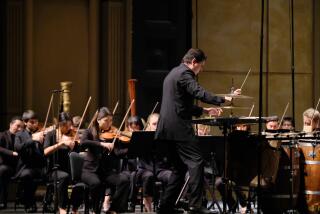The rise and bizarre fall of a musical prodigy
- Share via
He was a forlorn-looking figure, dressed in a rumpled gray raincoat that was shiny with dirt, like a mechanic’s apron. The woman sitting with him, at the Original Pantry restaurant in downtown Los Angeles, ate silently. The man appeared to be in his late 70s, his appearance hinting at homelessness, or something close to it.
It was 1978, and as my brother and I stole glances at him while we ate our dinner, it was hard to believe that this man was once touted as one of the greatest living pianists — a man who drew comparisons to his famous countryman, composer and pianist Franz Liszt.
His name was Ervin Nyiregyhazi. Earlier that year, NBC news had broken the story of the miraculous rediscovery of a “lost genius”: a former child prodigy from Hungary who, in the early 1920s, came to America and gave a series of “thunderous” piano concerts that made a huge impact on the musical world, before abruptly vanishing from sight.
Stories of child actors losing their bearings later in life are common, of course. But in the history of 20th century classical music, rich with eccentrics though it is, the story of Nyiregyhazi (“NYEER-edge-hah-zee”) stands out. A combination of bad luck, bad judgment and perhaps a loss of nerve condemned the Hungarian genius to decades of isolation and poverty in flophouse rooms, living on the fringes of life, both musical and otherwise.
At 13, he was the subject of a book, “The Psychology of a Musical Prodigy,” by Geza Revesz, who compared the boy to Mozart. Revesz recorded that Erwin was composing music by age 6, possessed absolutely perfect pitch and could sight-read the scores of symphonies. From memory, he could play piano pieces he had read but never heard.
He had already performed for European royalty before taking New York by storm, playing Carnegie Hall in 1920. His dramatic style thrilled some critics and horrified others. Then an ugly, and public, falling out with his manager suddenly soured his name. Humiliated, he decided to go west.
Upon his arrival in L.A. for a series of concerts in 1923, The Times summed him up in a nutshell: “Ervin Nyiregyhazi … may be termed a genius by mention of the following facts.... At his present age of 19 he plays more concertos than he is years old; he plays more than sixty of the most difficult of Liszt’s compositions, and … he has appeared in public throughout most of Europe and America since the age of 5.”
But reactions to Nyiregyhazi’s “clangorous” Romantic style from L.A.’s classical music establishment were mixed, as can be gleaned from his sometimes humorous notices in The Times:
From 1924: “Nyiregyhazi has a particular feeling for massive effects, tremendous climaxes which he would not infrequently make continuous if this were possible, and dramatic intensity generally.... To the unlearned student his noisy playing is apt to be a dangerous tonic.”
From 1928: “Certainly it is unusual to discover Liszt treating the piano as a percussion instrument … whether Liszt intended that effect for this particular composition or not is another question. Ervin Nyiregyhazi … plays so hard that the rafters in the auditorium shake.”
Nyiregyhazi loved Southern California. In 1928 he moved to L.A., more or less permanently. In many ways it was his undoing. Naturally, Los Angeles was glad to have him. For a young, upstart city it was a supreme treat and compliment to have the darling of Carnegie Hall and the “crowned heads of Europe” living in, of all places, Hollywood. But he may have sensed, in between scattered recitals for the Women’s Symphony Orchestra of Los Angeles or at the “Miniature Bowl” in Eagle Rock, that he was now a fish out of water. All evidence indicates, however, that at this point he didn’t even care.
Gradually, Nyiregyhazi gave up on a concert career. He moved into a cheap hotel on Main Street, the first of many. He later claimed that he’d always hated performing, saying it reminded him of being under his mother’s thumb. Still, he occasionally played in movie theaters, at churches and at private Hollywood parties.
In 1928, he took a job with United Artists, orchestrating and arranging film music. He made cameo appearances in a few films. Bela Lugosi, who always welcomed fellow Hungarians into his home, took Nyiregyhazi in and had him perform there often.
He was, according to his biographer Kevin Bazzana, “a magnet for women.” All told, he had 10 wives and countless affairs, including a tryst with Gloria Swanson.
The former prodigy continued living in skid row hotels in L.A. and later San Francisco. If his life struck others as depressing and tragic, Nyiregyhazi claimed otherwise. He was always composing music, he said, contentedly sipping bourbon. One of his compositions was titled “It’s Nice to Be Soused.”
On May 6, 1973, Nyiregyhazi gave a recital at the Old First Church in San Francisco. A man in the audience taped it on a cassette. He sent the tape to Gregor Benko of the International Piano Library in New York. Benko was astounded, and Nyiregyhazi’s years of obscurity were effectively over. CBS Records issued two LPs of new Nyiregyhazi recordings. His legacy was saved from oblivion by a hair’s breadth. The almost-lost genius died in 1987, and he was buried at Forest Lawn in Glendale.
More to Read
Sign up for Essential California
The most important California stories and recommendations in your inbox every morning.
You may occasionally receive promotional content from the Los Angeles Times.










